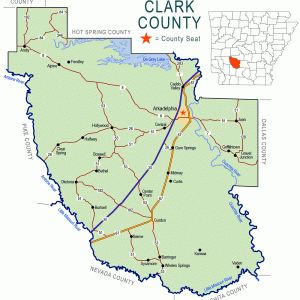calsfoundation@cals.org
Elm (Clark County)
Elm is a small community in the northwestern corner of Clark County less than one mile south of the border with Hot Spring County. The community is about five miles northeast of Amity (Clark County) and twelve miles west of Bismarck (Hot Spring County).
Early settlers in the area include the Dillard, Jones, and Ewing families. Oran Dillard arrived in the area around 1848 and cleared about twelve acres of land for crops. Dillard appears in the 1850 federal census along with his wife, Sally; three sons; and three daughters. The family owned land along the road connecting Murfreesboro (Pike County) and Rockport (Hot Spring County).
The first school, housed in a former home, opened in 1854, led by James Ewing. Other schools operated in the community until the construction of a purpose-built building in 1919, located on present-day Arkansas Highway 84. The building included a moveable partition that allowed the single large room to be made into two classrooms. The school served as a community gathering place that hosted various events, including spelling competitions and pie suppers. It burned several days before Christmas in 1935 during a holiday program. The desks and other school materials were saved, but the school bell was cracked when it fell to the ground. The school met for almost a year in a former home located across Highway 84. A replacement school opened in the fall of 1936 but only operated for a single year before the district consolidated with Amity.
Various businesses operated in the community in the late nineteenth and early twentieth centuries. A grist mill owned by the Dillard family operated in the community, along with several stores. The first store opened about two miles east of the Dillard family farm, and a second store eventually opened near Sugar Loaf Creek on the western edge of the community. Several blacksmith shops and physicians also operated in the community.
The Shiloh Church of Christ is located on land originally cleared by Oran Dillard. It was founded in 1870, and the first permanent building for the church was constructed of split logs in 1872 with a single door and no windows. In 1880, the building was moved back from the road and some improvements were made, including the addition of another door and two windows. It was replaced by a new building in 1893, and this new structure has been extensively remodeled over the years. The church continues to operate in the twenty-first century.
Several cemeteries are located in the community, including one near the Shiloh Church. Shiloh Cemetery includes graves dating to 1863, and it still has interments in the twenty-first century. There are two cemeteries named for the Dillard family: the Dillard Cemetery and the Dillard Homestead Cemetery. The Dillard Cemetery includes graves dating from 1869, while the Dillard Homestead Cemetery includes graves dating to 1864. Both continue to be used in the twenty-first century.
A post office under the direction of Berry Lambert opened in a room of Lambert’s home in 1889. Lambert requested the name of the post office be Big Elm due to the massive tree in his yard, but post office officials shortened the name to Elm. The tree was blown down in a storm in 1915.
The community received electric service in the early 1940s as part of a project under the Rural Electrification Administration. Completed by the South Central Arkansas Electric Cooperative, the project linked Elm with nearby communities such as Alpine (Clark County) and Point Cedar (Hot Spring County).
Elm is heavily forested, and most residents commute to nearby communities for employment.
For additional information:
Richter, Wendy, et al. Clark County, Arkansas: Past and Present. Arkadelphia, AR: Clark County Historical Association, 1992.
David Sesser
Southeastern Louisiana University
 Clark County Map
Clark County Map 




Comments
No comments on this entry yet.